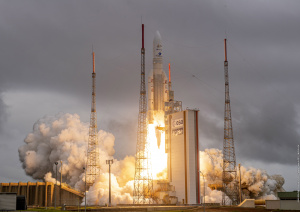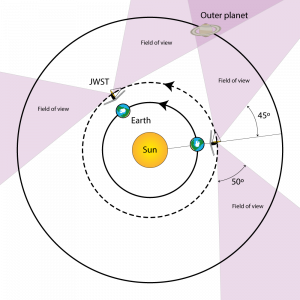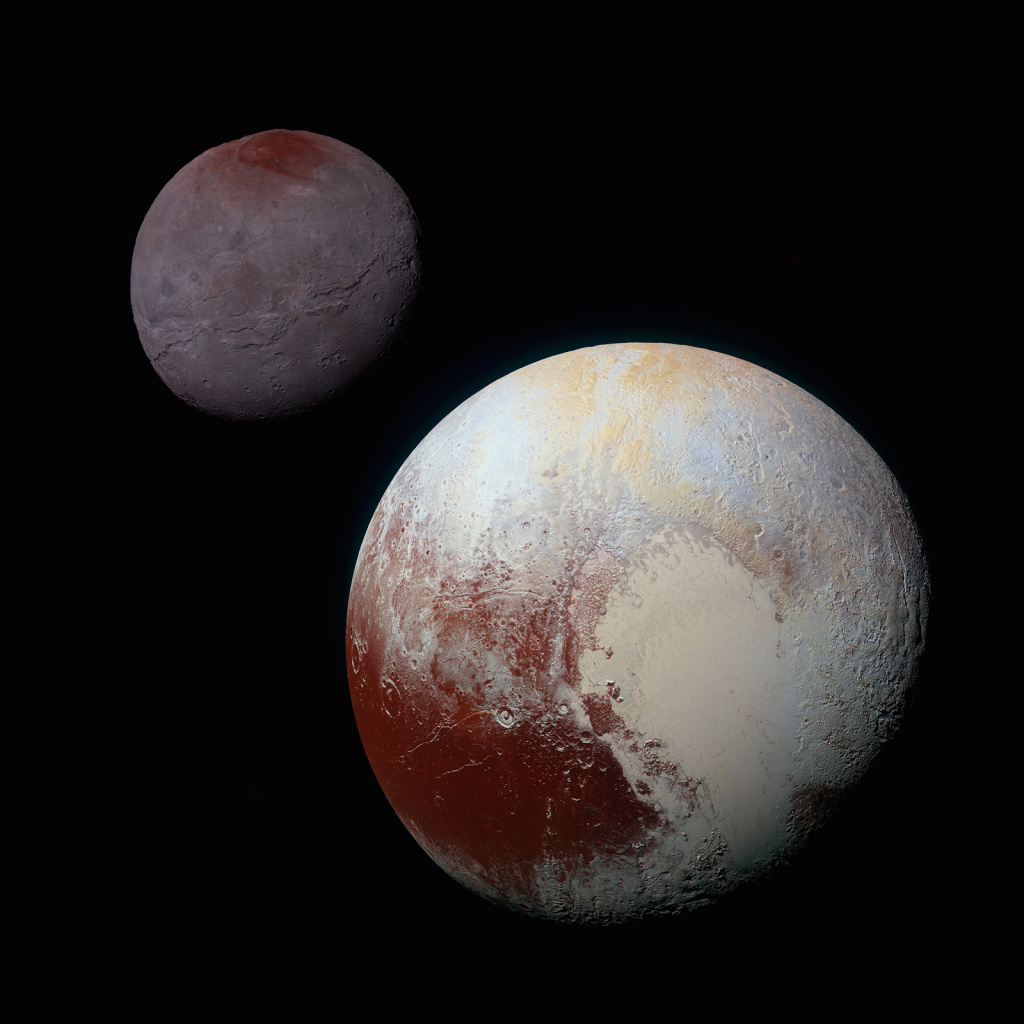JWST: A New Infrared Eye on the Solar System

Leigh Fletcher, Professor of Planetary Science at the University of Leicester (UK), reveals how the world’s most sophisticated infrared space telescope will provide exciting new opportunities for the exploration of our Solar System.
Read article in the fully formatted PDF of the Europlanet Magazine.
It is fair to say that nerves were a little strained as the Ariane-5 rocket rumbled skyward on 25 December 2021, carrying the most powerful space observatory ever built: the James Webb Space Telescope (JWST). Delicately folded within the Ariane fairing were the 18 segments of the enormous gold-coated hexagonal mirror, a collection of the most challenging instruments designed to date, and the multi-layered sunshield needed to shade the telescope and its cold instruments from the Sun.
After a near-perfect launch from the European spaceport of Kourou in French Guiana, astronomers, engineers, funding agencies and the public all shared an agonising month-long wait as the telescope and sunshield unfurled in space, a choreographed dance requiring more than 300 individual deployments.
In a feat of engineering that will go down in the history books, the unfolding of JWST proceeded without issues. By the end of January 2022, the new observatory was 1.5 million kilometres from home, orbiting a gravitational parking spot called the Second Lagrange Point (L2), hidden from the Sun and the Earth behind a sunshade and slowly cooling to the operating temperature of about 40 Kelvin (-233 degrees Celsius), required to make sharp infrared observations. By the end of April 2022, JWST had been aligned and focused, ready for the commissioning of the science instruments.
Infrared light allows astronomers to access realms that were previously hidden from view, being too distant, too cold, or too faint for previous generations of space- and ground-based telescopes. In the months and years ahead, an astronomical abundance awaits. JWST will peer back through cosmic history, using its exquisite infrared sensitivity to probe the earliest stars and galaxies, dive into dust-enshrouded nurseries for stars and planets, and probe the environments and atmospheres of a myriad of worlds within and beyond our Solar System.
Planetary Exploration with JWST
Early-on during the 25-year development of JWST, planetary scientists recognised the value of space-based infrared spectroscopy from this new facility. The observatory combines the spatial resolution of a 6.5-metre primary mirror, the extreme sensitivity of modern infrared detectors, and the ability to provide spatially-resolved spectroscopy from the near infrared up to the beginning of the far infrared. This enables JWST to span the spectral realms of reflected sunlight and thermal emission to investigate many vital molecules, ices and minerals, without the interference from the Earth’s atmosphere that plagues ground-based telescopes. This broad spectral coverage complements the instrumentation carried by missions visiting planetary bodies in our Solar System.
JWST’s spectral capabilities are enhanced by technologies that include ‘integral field units’ (IFUs) within NIRSpec and MIRI. IFUs speed up spectral analysis of planetary scenes by slicing the view into lots of smaller components and obtaining a spectrum for each component simultaneously. NIRCam and MIRI have filter wheels to capture images at different wavelength ranges, as well as coronagraphs to block bright sources and reveal faint objects nearby. An aperture mask on NIRISS turns JWST into an interferometric array and enables it to capture more details of very bright objects.
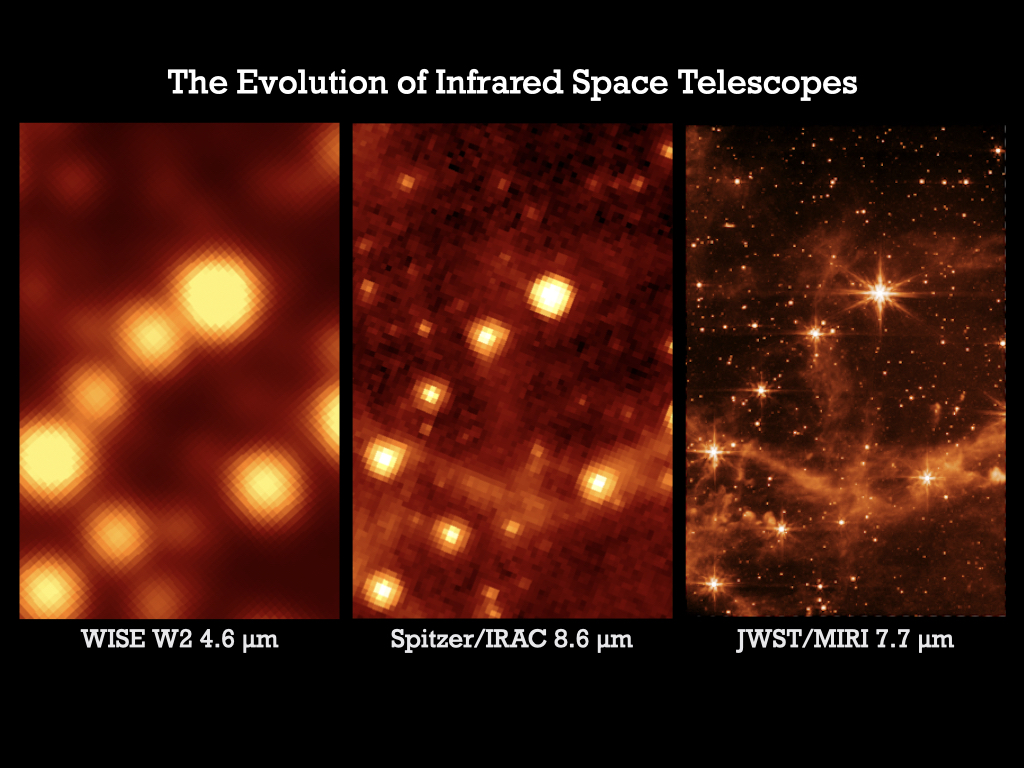
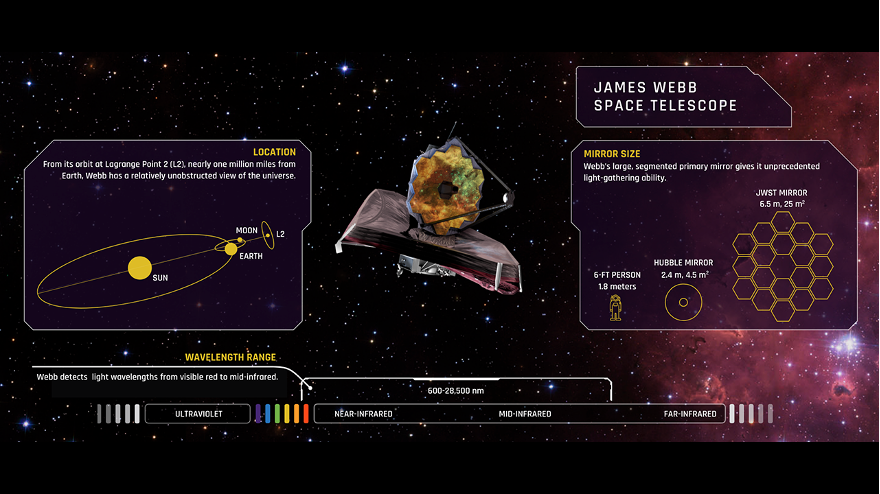
Instruments on JWST
JWST carries four main instruments, with multiple subsystems, enabling the observatory to investigate astronomical targets at a range of wavelengths:
- Near-Infrared Camera (NIRCam) is the observatory’s primary imager, covering the infrared wavelength range from 0.6 to 5 micrometres. NIRCam is provided by the University of Arizona.
- Near-Infrared Spectrograph (NIRSpec) enables low, medium and high-resolution spectroscopic observations in the near-infrared from 0.6-5.3 micrometres. NIRCAM is provided by the European Space Agency (ESA), with components provided by NASA Goddard Space Flight Centre.
- Mid-Infrared Instrument (MIRI) studies mid-infrared light from 4.9-28.8 micrometres, via imaging and spectroscopy at slightly longer wavelengths than the other JWST instruments, and is also equipped with a coronagraph to mask very bright features and reveal dimmer objects around them. MIRI is provided by the European Consortium with ESA, and by the NASA Jet Propulsion Laboratory (JPL).
- Fine Guidance Sensor/Near InfraRed Imager and Slitless Spectrograph (FGS/NIRISS). The FGS acts as the telescope’s eyes, allowing it to point at and focus on objects of interest. NIRISS can both take pictures and gather spectra. FGS/NIRISS are provided by the Canadian Space Agency.
JWST can track moving objects in our Solar System, such as comets and asteroids. However, because of the need to keep the observatory shaded, it can only view targets in certain parts of the sky and at certain times of year. The observatory orbits around the Sun in sync with the Earth, and the telescope points at an approximate right angle compared to its sunshield. This means it cannot look at planets at opposition (i.e. directly outwards along the Sun-Earth line), nor can it look towards the inner Solar System. It has two opportunities per year to view planetary targets like Mars or the Outer Planets, when they appear at roughly 90 degrees to the Sun from Earth (Figure 1).
With this arsenal of capabilities, planetary scientists had no shortage of ideas for how to put JWST to good use in the telescope’s first year of official scientific observations, ‘Cycle 1’, which starts in June 2022. In order to showcase the possibilities offered by JWST, and to help pave the way for future cycles, Guaranteed-Time Observations (GTO) were awarded to interdisciplinary scientists and mission specialists, who assembled teams to lead the development of some 18 individual GTO programmes that span the Solar System. These were reinforced in 2017 by the selection of Early-Release Science (ERS) programmes, which are designed to test and demonstrate JWST capabilities, and will be executed as soon as possible after the 6-month commissioning period and made immediately available to the scientific community. The Jupiter system, with its bright central planet, diverse satellites, and faint ring system, was selected as an ideal testbed.
Following the GTO and ERS allocations, more than 1000 proposals were submitted in 2020 for General Observer time (GO), of which 32% of principal investigators were from ESA member states. Solar System science was one of 18 topical panels, allocating more than 200 hours to 17 additional Solar System astronomy projects. At the time of writing, all these approved projects have been designed with the Astronomer’s Proposal Tool (APT), and are awaiting news of scheduling during Cycle 1 (2022-23).
The Realm of the Giants
The Gas Giants, Jupiter and Saturn, provide extended, bright, rotating and moving objects that will test JWST’s capabilities to create spectroscopic maps of their dynamic atmospheres. Indeed, both planets are so bright in the mid-infrared that MIRI spectroscopy is expected to saturate at the longest wavelengths, providing a challenge for calibration. The IFUs have fields of view almost an order of magnitude smaller than the diameter of Jupiter. JWST will therefore target specific phenomena.
A mosaic of Jupiter’s Great Red Spot and its surrounding environment will help to understand the distribution of gases and colourful hazes within the storm. Mapping of the south polar region will help to determine how auroral heating affects the deeper stratosphere and polar vortices. Mapping Saturn’s northern summertime hemisphere – including the famous hexagon and central polar cyclone – will support studies of seasonal evolution on the gas giant, some five years after the demise of the Cassini mission.
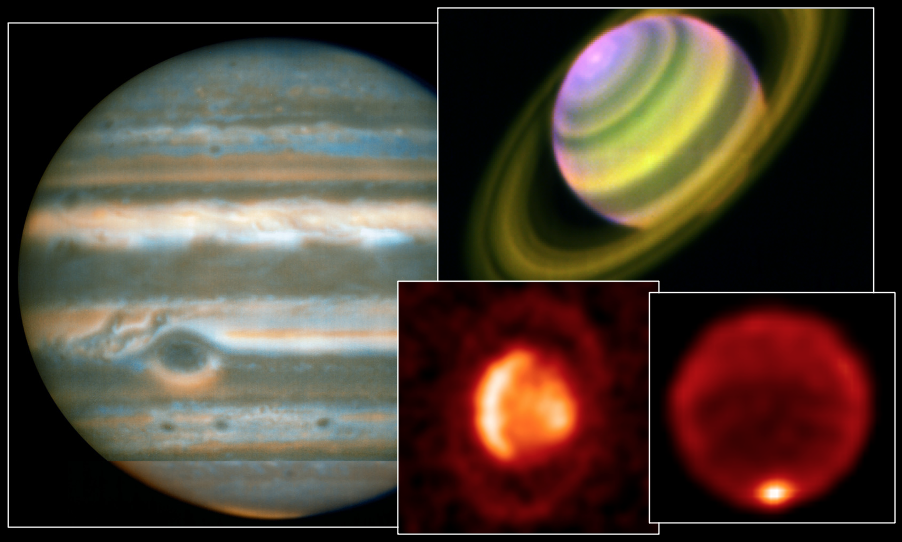
Further out, the Ice Giants, Uranus and Neptune, fit perfectly within the JWST fields of view, so that global maps of both worlds can be generated as the planets complete their daily rotations every 16-17 hours. Having been visited only once by Voyager-2 in the 1980s, there is still much that remains a mystery about their frigid environments. Earth-based studies of Uranus and Neptune from 8-metre class observatories have been restricted by the planets’ extreme distance and low temperatures, producing infrared signals that are so weak that our knowledge of their middle and upper atmospheres (e.g. the stratosphere and ionosphere) remains in its infancy. JWST will provide access to these previously hidden regions, opening a new programme of research for this unique category of planetary object ahead of future missions visiting the Ice Giants.
JWST will explore the space surrounding the giant planets themselves, providing a survey of their diverse satellite systems. NIRSpec investigations of the jets emanating from the subsurface layers of Europa and Enceladus may provide access to the chemical composition of their deep, hidden oceans, probing the processes at work beneath their icy crusts to assess their potential habitability.
The exosphere, surface composition and thermal emission of Ganymede will be mapped by NIRSpec and MIRI, whilst also searching for Ganymede’s auroral emission during a jovian eclipse. Io’s volcanic hotspots will be mapped during eclipse to determine lava temperatures and to understand the control of the thin atmosphere by the volcanic activity. The distributions of carbon- and nitrogen-rich species on Callisto will be revealed via NIRSpec mapping, whilst searching for ‘pure CO2’ ices within giant impact basins. Spatial mapping of the surfaces of these satellites will also help to identify unique terrains and active regions, which will be an invaluable guide for future missions like NASA’s Europa Clipper and ESA’s JUpiter ICy moons Explorer (JUICE).
Spectral maps of Titan, using both NIRSpec and MIRI, will build on the legacy of Cassini to study clouds, hazes and gases during Titan’s northern summer, and will use MIRI’s high spectral resolution to search for previously-undetected species in its chemically-rich stratosphere.
NIRCam observations of the jovian and saturnian ring systems will provide a sensitive search for new clumps or moonlets, whilst also providing a test of JWST scattered light capabilities close to the central planets. Not to be outdone, the Ice Giants’ systems will be explored via NIRSpec observations of Uranus’s classical satellites (Ariel, Umbriel, Titania and Oberon), as well as Neptune’s captured moon Triton, to reveal the possible presence of ammonia-rich species, organics and carbonates on their volatile-ice-rich surfaces, providing hints of past ocean-world activity on these moons.
Building Blocks of Planets
JWST will explore the remnants of Solar System formation and planetary migration, from large asteroids (e.g. Ceres, Pallas, Hygiea), to Jupiter Trojan asteroids (Patroclus, Eurybates, and other targets of NASA’s Lucy mission), providing compositional information from NIRSpec and MIRI to extend the wavelength coverage beyond the capabilities of Lucy. In addition, JWST will characterise the composition and potential presence of water on the surface of (16) Psyche – a representative metallic asteroid that could be the exposed core of a primordial differentiated object, and the target of NASA’s Psyche discovery mission. Alongside these M-type asteroids, JWST will also investigate the existence of calcium-aluminium inclusions (CAIs) on rare L-type asteroids, which hint at a potentially ancient origin, and test the distribution of materials in the early Solar System.
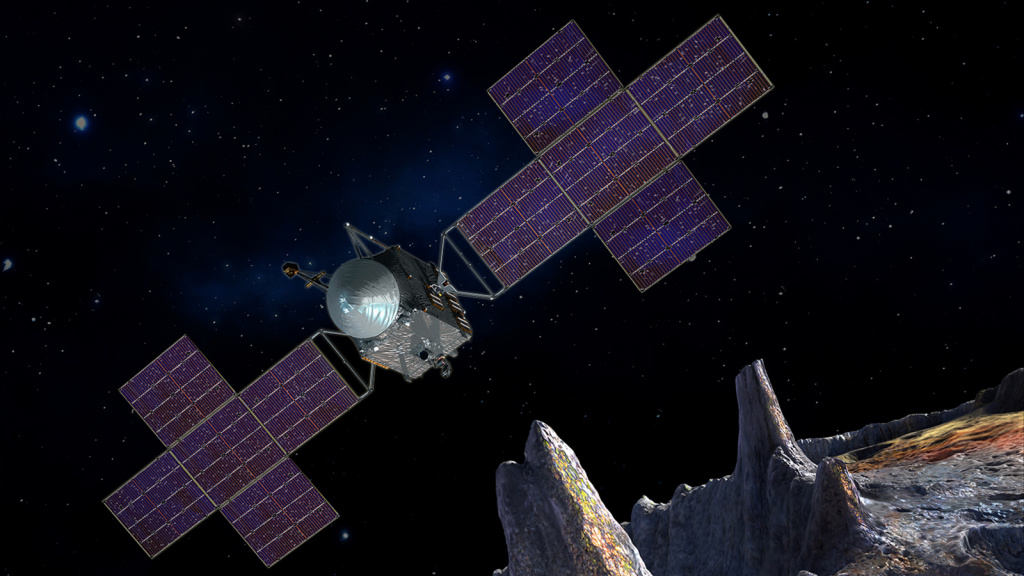
Closer to home, JWST will provide infrared observations of the Near-Earth Objects Phaethon (linked to the Geminids meteor shower and target of the DESTINY+ mission) and Didymos (target for the DART mission) to provide insights into the nature of the near-Earth population, examining their composition and searching for any signs of activity.
The gas and dust (silicate and carbonaceous materials) within the inner comas and nuclei of comets – including a main belt comet, a Jupiter-family comet, and potentially a new dynamic comet (if a suitable example is discovered during Cycle 1) – will be mapped to understand how comets may have delivered pre-biotic materials from the outer Solar System to the evolving terrestrial planets. JWST will also capture an unprecedented new view of the Oort-cloud comet, C/1995 O1 (Hale-Bopp), while it is 46 Astronomical Units (nearly 7 billion kilometres) from the Sun and at such a low temperature that most of the ices will be stable on the surface. Future observations of cometary nuclei and comas at different heliocentric distances will build a census of these objects, beyond the single-target observations of individual spacecraft missions.
Worlds Beyond Neptune
The composition of even the largest Trans-Neptunian Objects (TNOs) and Kuiper Belt Objects (KBOs) remain poorly constrained, yet understanding their chemical make-up could reveal the end-state of accretional processes in the outer Solar System and subsequent evolution via collisions and migration (e.g. Centaurs and scattered objects). JWST can characterise almost every KBO and TNO discovered to date, and will be determining the surface composition of a large sample of almost 60 TNOs, as well as searching for some of the faintest 10-kilometre sized TNOs. The exquisite NIRSpec and MIRI sensitivity will reveal new insights into their icy surface composition, temperatures and thermal inertias, crystallinity and grain sizes, as well as enable a search for potential organic species.
Cycle-1 targets include the dwarf planet Makemake, the Haumea collisional family, and the KBOs Varuna, Sedna, Eris, and Quaoar. JWST spectroscopy will bring new insights into Centaurs (small bodies that display properties both of comets and asteroids), including the processes shaping their colours (i.e. reddening) and how Centaurs display cometary activity as they move inwards from the ‘Scattered Disc’ beyond Neptune to join the short-period Jupiter-family comets. Cycle-1 will also provide an inventory of volatile compounds on the TNOs Orcus and 2003 AZ84 (both similar to Pluto’s companion, Charon), to understand the consequences of possible past cryovolcanism (and the influence of ammonia as an anti-freeze). The composition of Centaurs will be compared to that of Neptune’s Trojan asteroids to understand how reddening of planetary bodies is linked to composition, irradiation and grain size distributions. Occultations of background stars by foreground TNOs or Centaurs will be used to study the size, shape, and potential atmospheres/rings of these objects.
Finally, the Pluto and Charon system will be studied with MIRI and NIRSpec spectroscopy, building on the discoveries of the New Horizons flyby to explore Pluto’s climate evolution, plus the thermal and compositional properties of their surfaces.
Monitoring Mars
Moving closer to home, JWST will also be able to provide new insights on Mars. From its vantage point at L2, JWST will be able to make spectroscopic measurements across the full observable disc of Mars and study short-term and seasonal effects. It will map the atmospheric composition of Mars and investigate the deuterium/hydrogen ratio (an important marker for the history of water on Mars), methane, trace gases, and the CO2 emissions from the martian mesosphere (enabling a high-resolution picture of this region of Mars’s atmosphere for the first time). JWST will also study the variability of dust and ice clouds, and the hydrated minerals on the surface.
Expect the Unexpected
The descriptions in this article deal with objects where a long-term plan of observations is possible. But what about those dynamic Solar System events that are hard to predict in advance?
JWST allows proposals for ‘targets of opportunity’, so that regular observations can be interrupted under extreme circumstances, such as for large-scale cometary or asteroid impacts on Jupiter or Saturn, a spectacular new comet journeying towards the Sun, or possibly even the discovery of a new interstellar object passing through our Solar System. JWST is ready for each of these eventualities and, potentially, the most exciting new revelations will come from phenomena that cannot be predicted in advance.
Exciting Times
When commissioning ends and JWST science begins, planetary scientists can expect a treasure trove of new discoveries spanning our Solar System. These will reveal new insights into the origins and properties of planetary systems, allowing us to assess how the building blocks of habitable worlds might have formed, and how these shaped the ability of our fragile home to sustain the emergence of life. Exciting times are ahead!
Twitter: @LeighFletcher
https://planetaryweather.blogspot.com
Leigh Fletcher is supported by a European Research Council Consolidator Grant. (GIANTCLIMES), awarded under the European Union’s Horizon 2020 research and innovation programme, grant agreement No. 723890. He is a member of the Europlanet Society Executive Board.

